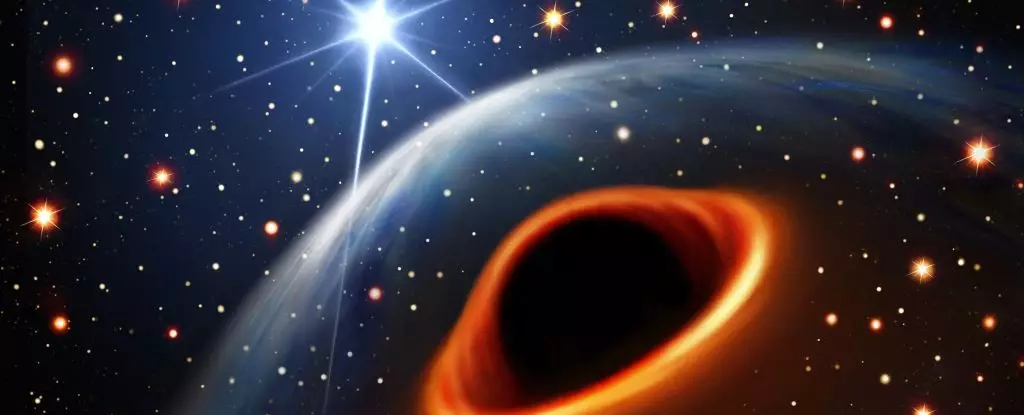At the sprawling expanse of 5,825 light-years from Earth, a fascinating astronomical phenomenon is unfolding around a red giant star, known as G3425. This star, seemingly engaged in a peculiar orbital pas de deux with an unseen binary partner, has recently sparked the interest of astronomers. The intriguing twist lies in the absence of any light emanating from the location where this companion should exist. Recent investigations, led by a team from the Chinese Academy of Sciences under researcher Song Wang, have hinted at a possibility that could reshape our understanding of black holes and their formation.
G3425 exhibits movement that behaves like a slow orbital dance—a phenomenon observed often in binary star systems. However, the crux of the matter is the mystery shrouding its companion; there is no observable light from the expected source, creating an enigma that challenges prevailing theories in astrophysics. Through careful observation of G3425’s behavior, astronomers have estimated the mass of its unseen partner to be roughly 3.6 times that of our Sun. This peculiar finding leads to an intriguing conclusion: the presence of a black hole that resides within the so-called “mass gap.”
The mass gap concept refers to a perplexing range of masses where very few black hole candidates have been detected, lying between the mass of neutron stars and the more massive black holes that are typically observed. The research team posited that the identification of G3425 sheds light on the elusive category of mass-gap black holes, indicating their existence in unique binary systems that elude detection through traditional methods like X-ray emissions.
Black holes are the remnants of collapsed stars, formed when a stellar core succumbs to gravitational forces after exhausting its nuclear fuel. Typically, the life cycle of stars can be categorized into stages leading to the creation of various dense objects based on their original mass. For instance, white dwarfs emerge from stars with a mass up to eight solar masses, while those that exceed this limit, approximately up to 2.3 solar masses, may transform into neutron stars. When stellar remnants exceed this threshold, they face a collapse that culminates in the formation of a black hole.
However, the mass gap suggests a limit to our understanding, as not many candidates below five solar masses have been discovered. This raises questions: Are we overlooking them due to detection difficulties, or is there an underlying phenomenon that limits their formation? Traditional methods of identifying black holes are chiefly reliant on their interactions with surrounding matter—particularly when they are actively consuming material, resulting in the emission of X-rays as the matter spirals into the black hole.
The pursuit of understanding G3425 and its mysterious companion has been significantly enhanced by data from the European Space Agency’s Gaia mission. Gaia’s ongoing endeavor to create a three-dimensional map of the Milky Way includes meticulously tracking the motions of stars and their velocities. This capability has transformed how astronomers approach binary systems that may be harboring invisible partners.
Using sophisticated techniques such as spectroscopy, Wang’s team was able to analyze the light variations emitted from G3425 as it moved in relation to its center of mass, revealing critical details about its orbital characteristics. Observations indicated that the red giant star has a mass approximately equivalent to 2.7 solar masses and follows a relatively stable and circular orbit, completing a full revolution roughly every 880 days. This is notable, as typical black hole binaries are characterized by more elliptical orbits due to the dynamic aftermath of supernova explosions.
The orbital dynamics observed in G3425 introduce a wealth of questions, challenging existing theories surrounding binary star evolution and the processes governing supernova explosions. The implication of a stable, wide circular orbit questions the traditional view of how these systems evolve post-supernova. Are the gravitational interactions within these systems more nuanced than previously thought? As G3425 provides a rare glimpse into the behavior of mass-gap black holes, it suggests that there may be other low-mass black holes scattered across the galaxy waiting to be identified.
To deepen our understanding of this overlooked population of black holes, the astronomical community will need to expand its search for other candidates within the mass gap. By collecting statistical data and examining the characteristics of these elusive objects, researchers may eventually unravel the complexities of black hole formation and evolution, reshaping our cosmic narrative in the process.
The discovery associated with G3425 serves as a poignant reminder of the depths of our universe still waiting to be explored. By probing the nuances of binary star systems and their enigmatic companions, astronomers are paving the way for a new frontier in black hole research—one that challenges established paradigms and expands our understanding of the cosmos. As we look beyond the observable universe, it becomes increasingly clear that the quest for knowledge is only just beginning.


Leave a Reply